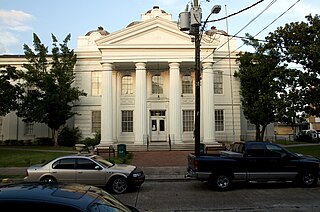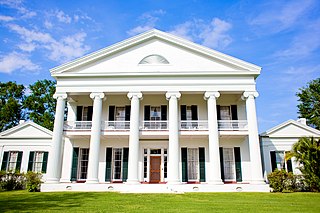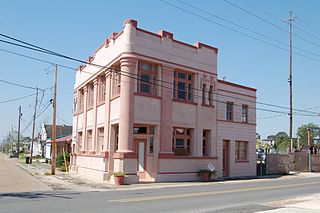
Lafourche Parish is a parish located in the south of the U.S. state of Louisiana. The parish seat is Thibodaux. The parish was formed in 1807. It was originally the northern part of Lafourche Interior Parish, which consisted of the present parishes of Lafourche and Terrebonne. Lafourche Parish was named after the Bayou Lafourche. City buildings have been featured in television and movies, such as in Fletch Lives, due to its architecture and rich history. At the 2020 census, its population was 97,557.

Donaldsonville is a city in, and the parish seat of Ascension Parish in the U.S. state of Louisiana. Located along the River Road of the west bank of the Mississippi River, it is a part of the Baton Rouge metropolitan statistical area. At the 2020 U.S. census, it had a population of 6,695.

Thibodaux is a city in, and the parish seat of, Lafourche Parish, Louisiana, United States, along the banks of Bayou Lafourche in the northwestern part of the parish. The population was 15,948 at the 2020 census. Thibodaux is a principal city of the Houma–Bayou Cane–Thibodaux metropolitan statistical area.

The Old State House, formerly called the Arkansas State House, is the oldest surviving state capitol building west of the Mississippi River. It was the site of the secession convention, as well as the fourth constitutional convention when delegates agreed to ensure voting rights for freedmen and establish public education.

Edward Douglass White Jr. was an American politician and jurist. White, a native of Louisiana, was a U.S. Supreme Court justice for 27 years, first as an associate justice from 1894 to 1910, then as the ninth chief justice from 1910 until his death in 1921. White is known for siding with the Supreme Court majority in Plessy v. Ferguson, which upheld the legality of state segregation.

The Pitot House is a historic landmark in New Orleans, Louisiana, and is listed on the National Register of Historic Places.

The Louisiana State Museum (LSM), founded in New Orleans in 1906, is a statewide system of National Historic Landmarks and modern structures across Louisiana, housing thousands of artifacts and works of art reflecting Louisiana's legacy of historic events and cultural diversity.

Madewood Plantation House, also known as Madewood, is a former sugarcane plantation house on Bayou Lafourche, near Napoleonville, Louisiana. It is located approximately two miles east of Napoleonville on Louisiana Highway 308. A National Historic Landmark, the 1846 house is architecturally significant as the first major work of Henry Howard, and as one of the finest Greek Revival plantation houses in the American South.

The Presbytère is an architecturally important building in the French Quarter of New Orleans, Louisiana. It stands facing Jackson Square, adjacent to the St. Louis Cathedral. Built in 1813 as a matching structure for the Cabildo, which flanks the cathedral on the other side, it is one of the nation's best examples of formal colonial Spanish architecture. It was designated a National Historic Landmark in 1970, and is now a property of the Louisiana State Museum.

Shadows-on-the-Teche is an American 3,750 square feet (348 m2) historic house, garden, and cemetery. Formerly a working sugar cane plantation with enslaved labor, it is located in New Iberia, Louisiana, United States. Built in 1834 for planter, David Weeks (1786–1834) and his wife Mary Conrad Weeks (1797–1863). The property is also home to the Shadows-on-the-Teche cemetery.

This is a list of the National Register of Historic Places listings in Lafourche Parish, Louisiana.

Longfellow-Evangeline State Historic Site, located in St. Martinville, Louisiana, showcases the cultural significance of the Bayou Teche region. It is the oldest state park site in Louisiana, founded in 1934 as the Longfellow-Evangeline State Commemorative Area. Evangeline was Henry Wadsworth Longfellow's enormously popular 1847 epic poem about Acadian lovers, who are now figures in local history. In the town center, the Evangeline Oak is the legendary meeting place of the two lovers, Evangeline and Gabriel. A statue of Evangeline marks her supposed grave next to St. Martin of Tours Church. The state historic site commemorates the broader historical setting of the poem in the Acadian and Creole culture of this region of Louisiana.

Rienzi Plantation House is a historic mansion located at 215 East Bayou Road in Thibodaux, Louisiana.

The St. Anne Catholic Church in Napoleonville, Louisiana is a historic Roman Catholic church which was built in 1909. It is located about four blocks inland from Bayou Lafourche at 417 St. Joseph Street, as part of a two-block parcel which includes a contributing rectory (1895) and a contributing cemetery, as well as three non-contributing buildings. It was added to the National Register in 2001.

Gibson Methodist Episcopal Church is a historic church on S. Bayou Black Drive in Gibson, Louisiana. It was built in 1849 and added to the National Register of Historic Places in 1986.
The Acadia Plantation was a historic plantation house in Thibodaux, Louisiana, U.S.. It was the plantation of James Bowie, Rezin P. Bowie, and Stephen Bowie. James "Jim" Bowie, served in the Battle of the Alamo. It was listed on the National Register of Historic Places on May 29, 1987. It was demolished in 2010.

Elkins Hall is a historic administrative building located on the north side of the campus of Nicholls State University fronting Bayou Lafourche. It was the first building constructed on the campus of what was then known as Francis T. Nicholls State College.

The Bouverans Plantation House, also known as Arialo, is a historic house on a former plantation in Lockport, Louisiana. It was built in 1860 for M. J. Claudet. It was one of the most productive sugarcane plantations in the parish in 1871–1872.

The Merchants and Planters Bank, also known as the Old LP&L District Office Building and now hosting the Bayou LaFourche Folklife and Heritage Museum is a historic bank building located at 110 Main Street in Lockport, Louisiana.

Zephirin Toups Sr. House is a historic house located along Bayou Blue Bypass Road, about 5.9 miles (9.5 km) southeast of Thibodaux, Louisiana.
























